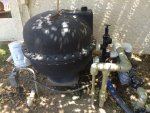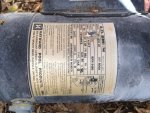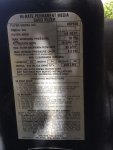2014 is the year of the pool.
Just when I think everything is going smoothly, another issue. I'm so thankful to have someplace to turn for advice.
I noticed Wednesday morning that the pump wasn't running. Finally got some folks out to the house today. Motor sparks and smells bad and then the breaker trips and all is quiet ...
Here is a current picture of the equipment and motor/filter labels:


Arizona law requires that I get a two-speed or variable-speed motor.
I circulate water and run a pool vac that has its own return to a Jandy valve that allows me to control how much flow to each. I have to limit flow to the pool vac in order to minimize cavitation from the hoses.
The pump and filter were installed in 2003. I just changed (June) the sand in the filter when going through a "swamp to sparkly" process.
Plumbing, other than between filter and pump (2003) and the return for the pool vac (1994) are original. We bought house in 1989 - I do not know when pool was installed. House was built in 1978.
At a minimum I need to replace the pump. Is there really any benefit to me going variable speed without anything else hanging off it or is two-speed sufficient? Any reason to go higher than a 1hp motor with my pool/filter size?
The handles for the valves to divert water to aerator are brittle. Any value in replacing that plumbing now -- or, just wait until I have to? (these are the brownish pipes in front of the filter/plumbing)
Is there anything else I should consider adding/changing since I have to get someone out here anyway?
Anything else I should be asking / looking at?
I'd appreciate knowing brands/models to go with and what to stay away from as well.
Sorry for such a long post... Thanks in advance for whatever help you can provide.
Toni
Just when I think everything is going smoothly, another issue. I'm so thankful to have someplace to turn for advice.
I noticed Wednesday morning that the pump wasn't running. Finally got some folks out to the house today. Motor sparks and smells bad and then the breaker trips and all is quiet ...
Here is a current picture of the equipment and motor/filter labels:



Arizona law requires that I get a two-speed or variable-speed motor.
I circulate water and run a pool vac that has its own return to a Jandy valve that allows me to control how much flow to each. I have to limit flow to the pool vac in order to minimize cavitation from the hoses.
The pump and filter were installed in 2003. I just changed (June) the sand in the filter when going through a "swamp to sparkly" process.
Plumbing, other than between filter and pump (2003) and the return for the pool vac (1994) are original. We bought house in 1989 - I do not know when pool was installed. House was built in 1978.
At a minimum I need to replace the pump. Is there really any benefit to me going variable speed without anything else hanging off it or is two-speed sufficient? Any reason to go higher than a 1hp motor with my pool/filter size?
The handles for the valves to divert water to aerator are brittle. Any value in replacing that plumbing now -- or, just wait until I have to? (these are the brownish pipes in front of the filter/plumbing)
Is there anything else I should consider adding/changing since I have to get someone out here anyway?
Anything else I should be asking / looking at?
I'd appreciate knowing brands/models to go with and what to stay away from as well.
Sorry for such a long post... Thanks in advance for whatever help you can provide.
Toni

